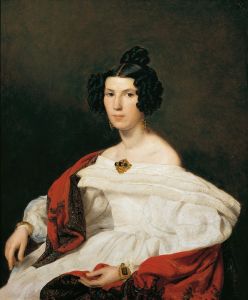
Dame in weißem Kleid
A hand-painted replica of Ferdinand Georg Waldmüller’s masterpiece Dame in weißem Kleid, meticulously crafted by professional artists to capture the true essence of the original. Each piece is created with museum-quality canvas and rare mineral pigments, carefully painted by experienced artists with delicate brushstrokes and rich, layered colors to perfectly recreate the texture of the original artwork. Unlike machine-printed reproductions, this hand-painted version brings the painting to life, infused with the artist’s emotions and skill in every stroke. Whether for personal collection or home decoration, it instantly elevates the artistic atmosphere of any space.
Ferdinand Georg Waldmüller (1793–1865) was an Austrian painter, widely regarded as one of the most important figures in 19th-century Austrian art. He is best known for his detailed and realistic depictions of landscapes, portraits, and genre scenes. Among his works is the painting "Dame in weißem Kleid" ("Lady in a White Dress"), which exemplifies his mastery of portraiture and attention to detail.
"Dame in weißem Kleid" is a portrait of a woman dressed in an elegant white gown, showcasing Waldmüller’s ability to capture the textures and intricate details of fabric, as well as the subtle play of light and shadow. The painting reflects the Biedermeier style, a period in Central European art that emphasized domesticity, simplicity, and a focus on middle-class life. Waldmüller was a prominent figure during this era, and his works often celebrated the beauty of everyday life and the natural world.
The identity of the woman depicted in "Dame in weißem Kleid" is not definitively known, as is the case with many of Waldmüller’s portraits. However, the painting demonstrates his skill in portraying the individuality and character of his subjects. The white dress, a central feature of the composition, is rendered with remarkable precision, highlighting the artist’s technical expertise and his interest in the interplay between light and material.
Waldmüller’s works, including "Dame in weißem Kleid," are often praised for their lifelike quality and emotional depth. His ability to combine realism with a sense of intimacy made him a sought-after portraitist during his career. In addition to his portraits, Waldmüller was also known for his landscapes, which often depicted the Austrian countryside with great fidelity and affection.
Today, "Dame in weißem Kleid" is recognized as an example of Waldmüller’s contribution to 19th-century European art. His works are held in high regard and can be found in various museums and collections, particularly in Austria. Waldmüller’s legacy continues to influence the study of Biedermeier art and the broader history of European painting.
This painting, like many of Waldmüller’s works, reflects the cultural and artistic values of its time, offering insight into the aesthetics and social norms of the Biedermeier period. Waldmüller’s dedication to realism and his ability to capture the essence of his subjects have secured his place as a key figure in the history of art.


















